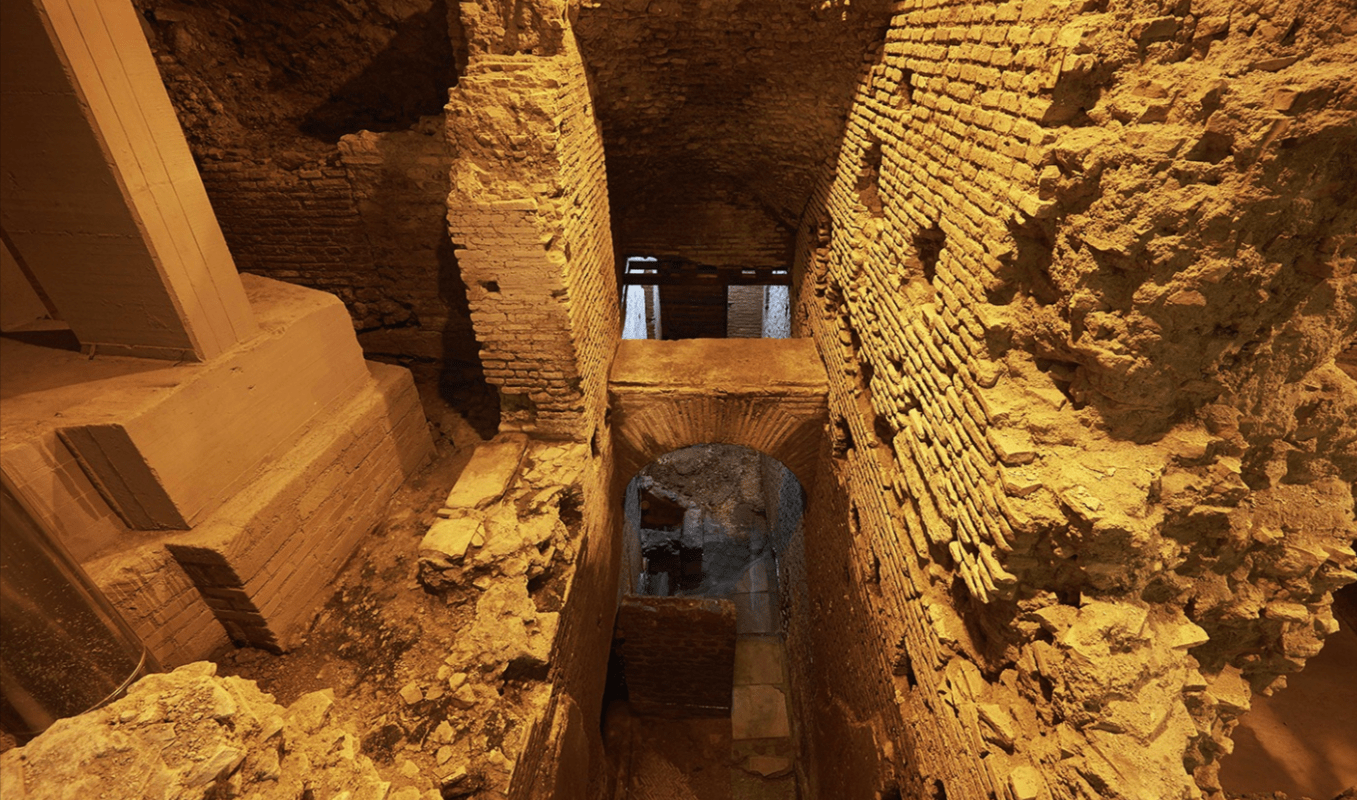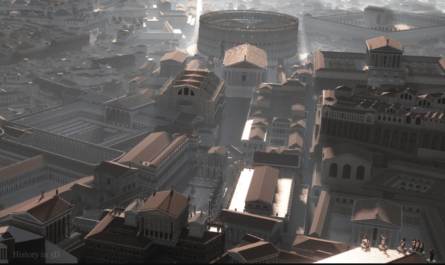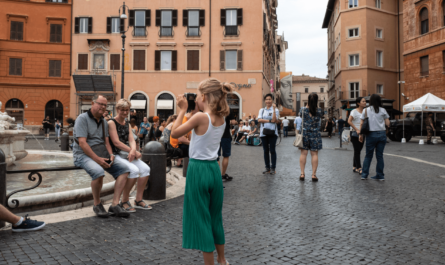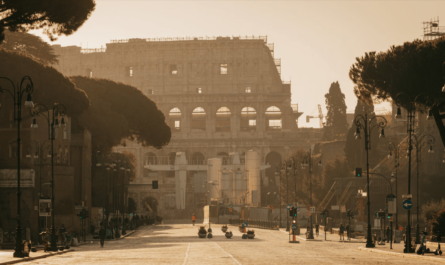Exploring Vicus Caprarius: It’s a well-known fact that Rome is brimming with secrets and hidden treasures. Stumbling upon a captivating underground world right next to famous landmarks like the Trevi Fountain is especially gratifying. I had heard about Vicus Caprarius on several occasions, but I hadn’t realized how close it was to the renowned Baroque fountain.
We discovered Vicus Caprarius almost by accident while exploring the Trevi district, and it completely enchanted us. I’ve created this guide to Vicus Caprarius to ensure you don’t miss it and to help you make the most of your visit. Inside, you’ll find key historical information about the site, the area’s significance, ancient Roman urban planning, and its role as a reservoir for the Aqua Virgo aqueduct.
Why Visit Vicus Caprarius in Rome
A visit to the Vicus Caprarius archaeological site is a fantastic addition to any trip to Rome. The site is compact and quick to explore, making it a perfect last-minute addition to your itinerary, whether you’re spending a week in Rome or just a few days.
If you’re a history enthusiast, interested in ancient Roman civilization, urban planning, and architecture, or just keen on discovering hidden gems, this site near the stunning Trevi Fountain will surely captivate you.
Still unsure if Vicus Caprarius should be on your list? Here are some compelling reasons to visit this small yet significant site in central Rome:
- Accessibility: It’s easy to find. Whether it’s your first visit to Rome or you’re a seasoned traveler, you’re likely to pass through the Trevi area and discover Vicus Caprarius almost by chance. Its manageable size means a brief visit is well worth it.
- Hidden Gem: It’s one of Rome’s lesser-known secrets that’s relatively easy to find. Why not explore this vital piece of Roman history and culture?
- Educational Value: Despite its size, Vicus Caprarius provides an insightful look into Roman history and the aqueduct system, enriching your experience in Rome.
- Affordability: The entrance fee is minimal, making it a budget-friendly option for exploring ancient history.
History of Vicus Caprarius
The Vicus Caprarius complex was located in Regio VII, an administrative region that bordered the Aurelian Walls, Via Salaria Vetus, and Via Lata (now Via del Corso). This area was part of Agrippa’s urban planning initiative, aimed at expanding Rome’s infrastructure.
The ancient route of Salaria Vetus, between the Aurelian Walls and the Trevi Fountain, aligns with today’s Via di Porta Pinciana, Via Francesco Crispi, Via del Tritone, and Via della Stamperia. The section corresponding to Via di San Vincenzo and Via dei Lucchesi was known as Vicus Caprarius.
Agrippa, known for constructing the Pantheon, inaugurated the Aqua Virgo aqueduct in 19 BC to supply water to his baths behind the Pantheon. Named for its pure water, Aqua Virgo was one of Rome’s eleven main aqueducts and is notable for its continuous operation into modern times, culminating in the majestic Trevi Fountain.
Vicus Caprarius, also known as “Città dell’Acqua” (City of Water), showcases the remnants of this vital water system.
Rome’s Oldest Insula
The complex is divided into northern and southern sections, each reflecting different historical periods. A brick stamp discovered in the northern building dates its origins to Nero’s reign, marking it as one of Rome’s earliest insulae (residential buildings).
This finding provides context for the extensive urban development along Via Lata and may offer rare evidence of Nero’s “nova urbs” following the 64 AD fire, previously known only through written records.
The insula originally featured an open-air courtyard and a staircase connecting the ground and first floors. Renovations in the 2nd century covered the courtyard, while further changes under Marcus Aurelius included an additional staircase. The 4th century saw significant upgrades, converting the insula into a luxury domus with ornate decorations, marble-covered staircases, and private bath facilities.
A fire in the 5th century, likely during the sack of Rome by the Vandals in 455, caused substantial damage to the domus. The ground floor was abandoned, marking a period of decline for many wealthy homes in Rome.
Castellum Aquae: Aqua Virgo Supply Tank
The southern complex, also dating to Nero’s reign, served public purposes rather than residential use. It originally stood around 11 meters (36 feet) high but today reaches approximately 6 meters (20 feet).
Throughout its history, the complex underwent multiple renovations, including significant updates during Hadrian’s rule. Changes to the water tank system involved creating adjoining compartments and reinforcing the walls to manage water pressure effectively.
The site exhibits a sophisticated water pipeline system linked to the Aqua Virgo aqueduct, as evidenced by the absence of calcareous deposits and the large water flow suited to public areas.
By the 6th century, the cistern fell into disuse following the Gothic invasion, which severed the aqueducts. Later, medieval structures were built on the site, reflecting a shift from imperial to medieval urban planning.
What to See in Vicus Caprarius Near Fontana di Trevi
Situated approximately 9 meters (30 feet) underground and covering about 350 square meters (3770 square feet), Vicus Caprarius was unearthed during the renovation of Cinema Trevi in the Rione Trevi. The site reveals an ancient neighborhood with buildings from various periods, illustrating the historical evolution of the area.
Among the artifacts are stamped bricks that helped identify different buildings and historical phases. These stamps also highlight the advanced construction industry in imperial Rome, once controlled by high-ranking citizens and later by the state under Marcus Aurelius.
The site includes a museum showcasing artifacts such as amphorae, which were used to transport goods like wine, oil, and garum (a popular fish sauce). The exhibition also features ceramics, oil lamps, and decorations from the imperial domus, including mosaic floor pieces, a marble statue, and Corinthian capitals.
Many relics, including nearly 900 bronze coins, were discovered beneath a 4-meter-high layer of dirt, revealing details about the wealth and status of the site’s former occupants.
Tips for Visiting Vicus Caprarius
- Book in Advance: Due to high demand, especially on weekends, it’s advisable to book your visit in advance. Reservations can be made by phone or WhatsApp.
- Wear Comfortable Shoes: The site involves some stairs and is dimly lit, so comfortable, flat shoes are recommended.
- Adjust Camera Settings: The underground environment requires proper camera settings for clear photos, with adjustments for ISO and lighting.
- Research Before You Go: To fully appreciate the site’s significance, reading up on Vicus Caprarius before your visit will enhance your experience.
Practical Information
- Address: Vicolo del Puttarello 25.
- How to Reach: Accessible by metro (Barberini stop, line A) or bus (52, 53, 62, 63, 71, 83, 85, 100, 117, 119, 160, 492).
- Opening Hours: Tuesday to Sunday, 11 am-5 pm; closed on Monday.
- Entrance Fee: €4.50 for adults, €2.50 for EU students (18-25), EU teachers, Roma Pass holders; €1 for 14-18-year-olds; free for under 14s, EU archaeology students, and Rome City Pass holders. Guided tours cost €8 and require prior booking.
- How to Book: Reservations can be made by phone or WhatsApp at +393397786192.
- Website: [Link]
What to See Nearby
Situated near the Trevi Fountain, Vicus Caprarius is an excellent addition to your itinerary. Nearby, you can explore other remnants of the Aqua Virgo aqueduct, including the Via del Nazareno site (requires booking) and the ruins in the undergrounds of La Rinascente department store on Via del Tritone.
Also nearby is Piazza Barberini, featuring the Triton fountain by Gian Lorenzo Bernini and the Palazzo Barberini Galleria Nazionale d’Arte Antica, accessible from Via delle Quattro Fontane.
Where to Eat Nearby
Several dining options are within walking distance of Vicus Caprarius. For gourmet pizza, try Piccolo Buco (Via del Lavatore 91). For a quick street food meal, La Sandwicheria (Via del Nazareno 16) offers fresh sandwiches and salads. Baccano (Via delle Muratte 23) provides traditional Roman dishes with a modern twist, and San Crispino (Via della Panetteria 42) is perfect for artisan gelato.



